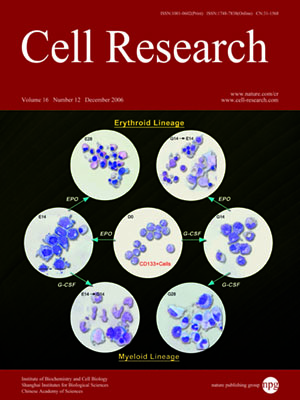
Volume 16, No 12, Dec 2006
ISSN: 1001-0602
EISSN: 1748-7838 2018
impact factor 17.848*
(Clarivate Analytics, 2019)
Volume 16 Issue 12, December 2006: 961-963
LETTERS TO THE EDITOR
Commonly used caspase inhibitors designed based on substrate specificity profiles lack selectivity
Alicia B Berger, Kelly B Sexton, Matthew Bogyo
1Department of Pathology, Stanford University School of Medicine, 300 Pasteur Dr., Stanford, CA 94305, USA; 2Cancer BiologyGraduate Program, Stanford University School of Medicine, 300 Pasteur Dr., Stanford, CA 94305, USA; 3Microbiology and Immunology,Stanford University School of Medicine, 300 Pasteur Dr., Stanford, CA 94305, USA
Correspondence: Matthew Bogyo(mbogyo@stanford.edu)
Dear Editor:
Caspase regulation and activation have been extensively studied since the discovery of this class of proteases almost two decades ago, yet surprisingly few tools are available that can be used to monitor individual caspase activities [1]. The most commonly used tools include caspase-specific anti-sera as well as fluorogenic substrates and inhibitors. Unfortunately, antibody reagents often do not provide an accurate measure of caspase activity since several caspase family members (caspases 8/10 and 9) do not require proteolytic processing for activation [2, 3]. Furthermore, recent evidence suggests that caspase-7 (an executioner caspase) activation occurs via a catalytically active full-length intermediate that cannot be differentiated from the non-cleaved inactive zymogen using antibodies [4, 5].
As an alternative to antibody-based reagents, small molecule substrates and inhibitors can be used to directly monitor caspase activity and a relatively large number of caspase substrates, inhibitors, and activity-based probes are now commercially available. These reagents have begun to find widespread use in cell biological and biochemical studies of caspase function. In most cases, these tools are used as selective reagents to assess the contribution of specific caspases to a given apoptotic pathway.
Virtually, all of the current commercially available reagents have been designed based on the reported optimal substrate specificity profiles for the caspases [6]. However, these primary peptide sequences may provide only limited selectivity when used in the context of a small molecule inhibitor. Interestingly, a comprehensive study of the selectivity of the most commonly used commercially available caspase inhibitors has never been reported. Thus, we felt that a study of the selectivity of these inhibitors towards endogenous caspases in complex proteomes would be extremely valuable. We chose to focus on three widely used covalent caspase inhibitors containing the optimal substrate specificity sequences DEVD, I/LETD, and LEHD designed to target caspases 3/7, 8, and 9, respectively. For these studies, we obtained three commercially available inhibitors (Z-DEVD-FMK, Z-IETD-FMK, and Z-LEHDFMK) equipped with a fluoromethylketone (FMK) reactive group. We also synthesized three inhibitors that contained the same peptide sequences (NP-DEVD-AOMK, NPLETD- AOMK, and NP-LEHD-AOMK) but linked to the acyloxymethylketone (AOMK) reactive group shown previously to be effective towards caspases [7, 8] (Figure 1A). To test inhibitor selectivity against caspases 3, 7, and 9 we used an apoptotic proteome in which the intrinsic apoptotic pathway is activated through addition of cytochrome c and dATP [9]. Since there is currently no simple method to monitor endogenous caspase-8 activity, we tested the inhibitors against purified recombinant caspase-8 at the physiologically relevant concentration of 50 nM (See Supplement 1 for Materials and Methods) [2].
To assess caspase inhibition, we added cytochrome c/dATP to cytosolic 293 extract and allowed the samples to incubate for 10 min at 37 °C at which time the panel of inhibitors was added at a range of concentrations and allowed to inhibit active caspases for 10 min. After incubation, the poly-caspase probe KMB01 (biotin-hex-EVDAOMK) [8] was added to label residual caspase active sites for an additional 30 min. After 10-min incubation with cytochrome c and dATP, KMB01 labels the fully cleaved
Cell Research (2006) 16:961-963. doi: 10.1038/sj.cr.7310112; published online 21 November 2006
FULL TEXT | PDF
Browse 2282


